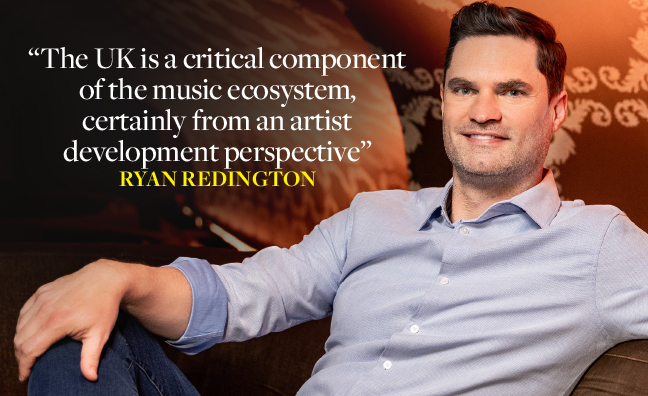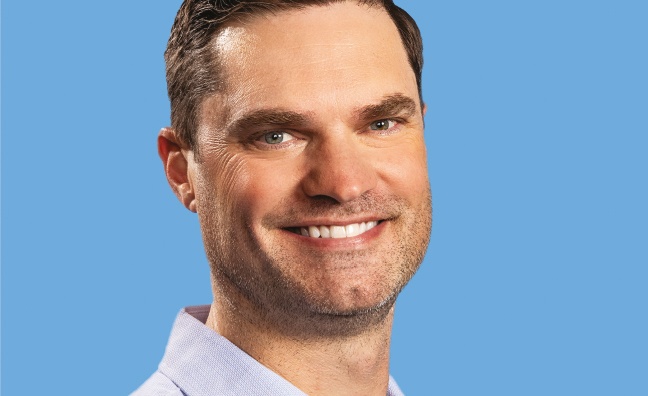Amazon Music veteran Ryan Redington is the subject of the Music Week Interview in our latest edition of the magazine.
Redington, who has spent 15 years at Amazon, was part of the launch of its streaming service in 2014. The Iowa native was elevated from VP, music industry to general manager in July 2023.
Redington’s vast remit includes overseeing departments such as artists and label relations, artist and genre marketing, programming, editorial and catalogue, plus the Amazon Music For Artists app.
Amazon Music, which increased its streaming subscription prices last year, expanded its offering for Prime members in late 2022, including a full catalogue of 100 million songs ad-free.
The platform has also flexed its muscles in the festive chart with its Amazon Original series, only available to Amazon Music users – almost netting the UK Christmas No.1 spot in 2023 with Sam Ryder’s You’re Christmas To Me, which peaked at No.2. The song also featured on the soundtrack for the Prime Video film Your Christmas Or Mine 2.
The streaming giant’s revised leadership hierarchy now sees former Amazon Music UK boss Paul Firth occupy a global role, while Laura Lukanz is head of music UK/ANZ. Ex-general manager and director, Amazon Music: Europe, Australia and New Zealand, Jillian Gerngross, exited in late 2023 after a decade in various roles, which prompted a restructure.
Here, in an excerpt from his exclusive Music Week Interview, Ryan Redington talks about the UK market, breaking talent and monetising fanbases for artists…
First of all, even though you are based in the US, how important a market do you consider the UK to be globally?
“The UK is a critical component of the entire music ecosystem, certainly from an artist development perspective – just as important as the US. We have a large team based in London and a really strong team. It’s just as vital as any part of the ecosystem as far as I’m concerned.”
Are there concerns about whether the UK is producing top global talent, though?
“I don’t think this is necessarily a UK concern as much as it is how the music industry looks at breaking artists these days. It’s different with the advent of social media and how a track can go viral so quickly, but also about ensuring the artist still gets to develop a stage presence and build a larger repertoire of content. I don’t necessarily pin this on the UK, but I think a great challenge for the music industry now is how does an act break? I think it’s become more difficult. Maybe part of it is Covid, but a lot of it is just the way you go to market. The ways that you advertise music, and how social media plays into helping develop an artist are changing rapidly. Developing artists is a big challenge for the industry.”

How is Amazon helping breaking artists as well as bigger names?
“We have our global breakthrough programme designated to giving Tier A-type artist exposure for developing artists, so we’re helping them both from a financial perspective, but also from a marketing and distribution perspective. We have smaller artist development funds around the world, and then our curation team spends a lot of time with the indie community around what artists are up and coming. And we have launched our Artists To Watch in different territories. There’s really not a day that goes by where the teams aren’t thinking about both the superstar artists and developing artists. The big artists of the future maybe haven’t broken today, so we need to make sure we’re nurturing that and doing our part.”
Can you tell us how much of your own time is focused on the UK?
“I just happened to be in London recently; I was visiting the team there and doing some internal meetings. I probably get over to London a couple of times a year. If you divide up my role into all the countries we operate in, we spend a lot of time around the localisation side and the global component of artists coming out of their respective countries, and thinking about the resourcing of the teams, headcount, budgets and those types of things. It’s hard for me to put a percentage on what the UK focus is, but it’s a significant portion of my job, given how important the UK is to the music industry.”
How have you helped artists monetise fanbases in your new role?
“If you step back and think about artists, they are operating small businesses and the way they’re creating new revenue streams is highly diversified. Certainly, the royalties they make from selling vinyl, CDs, or from streaming services is a part of that, but it’s not the entire pie. Two interesting areas for us – particularly on the reach side – is tapping into the distribution we have around Prime Video and Twitch, and the livestreaming space, both in festivals and concerts. We’ve been incredibly happy with some of the investments we’ve made in livestreaming over the last couple of years and you’ll continue to see us grow that space. On the monetisation component, we have great commerce capabilities across Amazon: we can ship fast, we have low prices, and working closely with artists around their merch business is a way to help their small business, if you will.
“We’ve invested in building up our merch capabilities. We can actually handle the back end of printing the shirt or the hoodie, or whatever it may be, and do the full manufacturing and shipping direct to customer. We’ve expanded into supporting artists on touring – the logistics and manufacturing, the point of sale within the venue – and creating exclusive drops that pair up with the tour and selling that online through Amazon. We did that with Beyoncé, for example. The feedback has been tremendous and it feels like we’re on to something special there.”
Last year, you said Amazon would use livestreaming more to connect artists and fans, via Prime Video, Twitch and the Amazon Music app. How have you been doing that?
“We’ve got much better at marketing and understanding how to reach fans in real time both on Twitch and Prime Video. We’re seeing livestream viewership and engagement grow tremendously year-on-year, so ’23 was a much bigger year than ’22 and our forecasts for ’24 are much larger than ’23. You’ll start to see us integrate merch drops during livestreams, and also taking some of the recorded music components where we’re tying a livestream around an album drop. We’ve been working closely with sponsors around how they can be a part of the livestreams, which has been compelling. The viewership and reaction we’re seeing from fans and artists’ camps is a good signal to us that it’s working.”
Looking ahead to the rest of this year and beyond, what single industry trend are you most excited or concerned about?
“This notion of fandom and how Amazon Music could play a differentiated role in that space. What doesn’t exist today is connecting those dots between watching and listening to live music, the merch, physical components of the world and the recorded music side of things, and you start to think about those things working together in a positive way to make a better fan and artist experience. We’re in an interesting place for that all to happen and I’m really excited about that. There’s a lot of work for us to do, but we’ve got the right team, the right model and a clear vision of where we want to go.”
Subscribers can read the full Music Week Interview with Ryan Redington here.
WORDS: JAMES HANLEY
PHOTOS: ROGER KISBY










